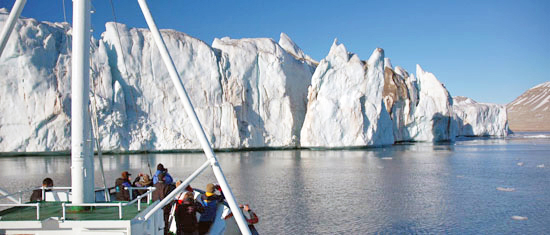
| Home » Products » North Spitsbergen, Early Arctic Spring |
North Spitsbergen, Early Arctic SpringAt the end of a long Arctic winter, spring is starting to awaken. The climate, however, still clings to the cold: snow-covered mountains, snow-swept shores, temperatures around –10° C (14°F). It’s a good time to experience the last of winter scenery, and with a little luck, also see some polar bears, walruses, and seals. ItineraryLargest town, biggest island You touch down in Longyearbyen, the administrative center of Spitsbergen, the largest island of the Svalbard archipelago. Enjoy strolling around this former mining town, whose parish church and Svalbard Museum make for fascinating attractions. Though the countryside appears stark, more than a hundred species of plant have been recorded in it. In the early evening the ship sails out of Isfjorden, where you might spot the first minke whale of your voyage. In the evening you sail for Trygghamna, where you see the remains of a 17th-century English whaling station and 18th-century Pomor hunting station, both of which you can visit the next morning. From Trygghamna you walk to Alkhornet, a large seabird cliff where the birds are scouting out breeding places. Below the cliffs is a common place to spot Arctic foxes, and you may also see reindeer grazing on the lush vegetation if there’s not too much snow Earth’s northernmost community You head north for Kongsfjorden and Krossfjorden. The landscape is likely to show signs of winter, the crags and slopes still blanketed with snow. Here there are rich opportunities for snowshoeing – we provide the snowshoes – and visiting places of historic interest: Ny London, where you can see the remains of early 20th-century marble mining, and Ny Alesund, the northernmost community in the world. There are also research stations and the famous anchor mast of the dirigible Norge, which took the first flight across the North Pole to Nome, Alaska in 1926. Krossfjorden offers views of colossal glaciers and lofty mountain peaks, but ultimately the extent of fjord ice dictates the itinerary here. Walrus watching, seal seeing Cutting south between the main island of Spitsbergen and Prins Karls Forland, you may encounter walruses at Poolepynten, a common haul-out site. You also have views of St. Johnsfjorden, near Gaffelbreen. The winter ice may not have loosened its grip on the water here, and seals (ringed and bearded) could be numerous in the area. Wide tundra, tall mountains You now double back into Isfjorden and venture to Ymerbukta, possibly embarking on a walk in this mountainous area. Here you find an expansive tundra with its own avifauna, depending on when spring arrives, as well as spectacular geological formations along the coast. Further northeast, near Ekmanfjorden, you have the chance for another hike. Common to this area are numerous glaciers that terminate near or in the sea. In Gipsvika you can go on shore near the cliff of Templet, a mountainous location of eroded sedimentary rock from the Upper Carboniferous period – around 290 million years ago. There and back again Every adventure, no matter how grand, must eventually come to an end. You disembark in Longyearbyen, taking home memories that will accompany you wherever your next adventure lies. NotesPLEASE NOTE: At the end of a long Arctic winter, spring is starting to awaken. The climate, however, still clings to the cold: ice-covered mountains, snow-swept shores, temperatures around –10° C (14°F). It’s a good time to experience the last of the winter scenery, and with a little luck, also see some polar bears, walruses, and seals into the bargain. Bird note: It is still somewhat quiet on the cliffs, as this time of year the cliff-nesting birds are only just arriving to pick out their breeding places. By May all the nesting birds will have arrived, and the breeding will take place later in June. All itineraries are for guidance only. Programs may vary depending on local ice, weather, and wildlife conditions. Flexibility is paramount for expedition cruises. Willingness to compromise on comfort is a basic requirement on board a historic sailing vessel. Important information about the sailing program: The boat is equipped with sails to be used in good conditions (based on open sea, water depth, wind, and time). This is not guaranteed. The captain decides whether to use the sails or the engine. There is no claim to one or the other propulsion method. If sails are used, the crew operates them. Guests must follow the safety instructions of the team. The average cruising speed for s/v Noorderlicht is 6 knots. Price IncludesAll Meals Throughout the Voyage Aboard the Ship Including Snacks, Coffee anAll Shore Excursions and Activities Throughout the Voyage by Zodiac. Program of Lectures by Noted Naturalists and Leadership by Experienced Expe Use of Rubber Boots and Snowshoes Transfers and Baggage Handling Between the Airport, Hotels and Ship Only Fo All Miscellaneous Service Taxes and Port Charges Throughout the Program. Aeco Fees and Governmental Taxes. Comprehensive Pre-Departure Material Price Does Not IncludeAirPre- and Post Land Arrangements. Government Arrival and Departure Taxes. Baggage, Cancellation and Personal Insurance (which Is Mandatory). The Customary Gratuity at the End of the Voyages for Stewards and Other Ser OCE-1269
|













